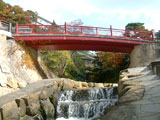
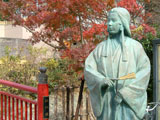
In the central part of Arima Onsen, there is a bridge with a red railing called Nene-bashi, located upstream of the Arimagawa River running nearby Arima Onsen station of the Kobe Railway. Near the bridge is a bronze statute of Nene, the lawful wife of Toyotomi Hideyoshi (honorific title: Taiko). From this place, visitors can climb down to the Arima River Shinsui Park. Every year, several events such as a cherry blossom festival and a river breeze festival are held and all the local people of Arima gather at the river site to participate in the merriment. In the evening, the red bridge and cherry trees are lit up and the contrast against the darkness creates a dreamy feeling.
The leaves of the trees near the Nene-bashi Bridge turn red first in Arima Onsen around the middle of October. A picturesque scene of autumn-tinted cherry trees in line can be seen on both sides of the river from the end of October to the end of November.
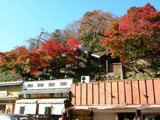

Taiko Street, which even in Arima Onsen is the liveliest street, extends from Nene-bashi Bridge on the right-hand side. After passing in front of the takeout tempura stall and souvenir shops and gazing your eyes over the steam of the popular "hot, steamed sweet buns," you'll arrive at the main gate of Zenpukuji Temple. Climb the stone steps facing the Hankyu Bus Arima Terminal to access the temple.
Founded in the 8th century by Gyoki, a monk whose name is venerated in Buddhism even today, Zenpukuji Temple is a temple steeped in history and lineage. Majestically standing in the temple's compound are four weeping cherry trees exceeding 260 years in age. Every year in the beginning of April, visitors come in large numbers to enjoy the beautiful sight of these trees in bloom. These cherry blossom trees are called the "trees of the Kobe citizens" as well as "Kobe's prized trees." In autumn, these trees attract a multitude of sightseers who direct their cameras toward the beautiful autumn leaves.
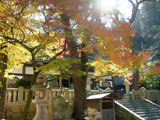
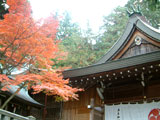
In addition to the temples and shrines such the Gokurakuji Temple, the Onsenji Temple, Tosen Shrine, and Nenbutsuji Temple, which is said to be imprint of the villa of Hideyoshi's legal wife "Nene," other attractions such as Gin-no-yu (Silver Bath) and Taiko no Yudonokan (Hideyoshi's Bath Museum) can be found in the central area of Arima Onsen called Tera-machi or Temple Town.
During the autumn season, the area bustles with sightseers who come to view the exquisite beauty of the changing leaves featuring the weeping cherry trees of Nenbutsuji Temple, the cherry trees of Onsenji Temple, and the maple trees found on the path to Tosen Shrine and beside its main hall. Splendid autumn leaves surrounding the town of Arima Onsen can be readily seen from Onsenji Temple, and we suggest taking it easy one autumn day to enjoy the elegance of Arima Onsen.
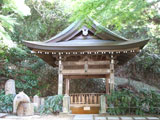
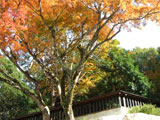
Passing along the street in front of Nenbutsuji Temple and Gokurakuji Temple and going further up the sloping path, you'll find the Tansan slope on the left hand side. At the top of that slope is "Tansan Sengen (Carbonic Acid Spring) Park." From the pond beneath this natural spring gushes out with mineral water (18.6℃) containing the occasional bubbles and carbonated gas. In 1875, this spring impregnated with carbon dioxide was used to make cider for the first time in Japan, and we recommend trying the refreshing flavor of the new edition of cider "Arima Cider Teppo Water" (You can find this at the Ryuusenkaku Gift Shop. 1 bottle is 250 yen)
Along with the large cherry trees, there are many maple and autumn-tinted trees in this park, too. Because of the proximity of the onsen town, it is easy to enjoy the beauty of cherry blossoms in the spring and the changing leaves of the autumn.


Arima Inari Shrine can be found on the hillside of Mt. Iba (formerly known as Mt. Kumuchi, elevation 689 m) when walking up the slope from the "Tansan Sengen (Carbonic Acid Spring) Park." Here, the Arima Temporary Palace was built more than 1,300 years ago for the emperor's accommodation during his stay in Arima. The guardian deity of this palace was the god Inari, and the Arima Inari Shrine was built to offer prayers. In 1904, flowers and plants of the four seasons were planted on the hillside of Mt. Iba, and the site for the Inari Shrine was moved away from the remains of the palace to its present location.
There are numerous broadleaf trees on the path approaching the shrine, and near the main hall of the shrine there are large maple trees and other trees exhibiting the vivid tints of autumn. On a high stage from the main hall of the shrine, there is an observation platform where the mountain range of three provinces of Tamba, Tango, and Tajima in the north of Hyogo and Kyoto Prefectures can be seen in the distance. Because of its spectacular view, it is counted as one of Arima's famous places, and we enthusiastically recommend seeing the scenery of the colorful autumn-tinted leaves on the mountains surrounding Arima Onsen.

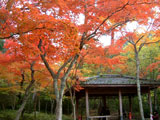
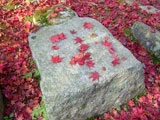
Zuihoji Park, known foremost within the Kobe City as a place famous for autumn leaves, is on the eastern side of the Zuihoji Valley, located at the source of Rokkogawa River or upstream of the Arimagawa River. Opened in 1604, Zuihoji Temple closed just after the Meiji Restoration in 1868. The Kobe municipal government established it as a park in 1951, and the Buddhist temple main gate at the entrance of the park was moved from Fushimi Momoyama Castle in 1868. Toyotomi Hideyoshi praised the tranquility of this beautiful Japanese garden saying, "No matter how much you see of it, you never grow tired of it." He regularly held Japanese tea ceremonies at Zuihoji Temple, and even today an Arima Major Tea Ceremony is held at the park every year on November 2nd and 3rd. Because of the beautiful cherry blossoms that can be seen in the spring, the park was selected as one of the 50 most famous cherry blossom-viewing spots of Kobe City.
In autumn, the old deciduous trees, numbering approximately 2,000 trees and including maple and ginkgo trees, add a crimson red tint to the landscape as the leaves change colors. Furthermore, there are resting places scattered around the park to relax with amazake (sweet drink made from rice), noodles, and oden (Japanese winter dish) served by a seasonal resting house called Momiji-chaya while viewing the beautiful autumn leaves. With a commanding view from the observation platform spanning from Sanda City to the Inland Sea of Seto, it is no wonder so many tourists visit here to view the landscape of changing autumn leaves.

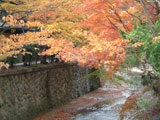
Located at the upper part of the Arimagawa River beside the Takigawa River, Tsuzumi-ga-taki (Hand Drum Waterfall) Park, along with Zuihoji Park, is a place famous for its cherry blossoms and autumn leaves. The park gets its name from the sound of water falling from the waterfall echoing like the sound of a hand drum, or tsuzumi, being struck in the surrounding rock. With an attraction for every season, Tsuzumigataki Park features Ariake cherry blossoms in the spring, fireflies in the beginning of summer, and the vivid colors of the changing leaves in autumn. The scenery is considered one of the "Six Views of Arima."
In the vicinity of Tsuzumigataki Waterfall, there are many maple and autumn-tinted trees. During the changing of the seasons, it is enjoyable to view the red-tinted maple leaves while listening to the gurgling of the Takigawa River from the path of the waterfall to the Tsuzumigataki Park. In particular, many rare types of trees that change colors in the autumn remain upstream of the Takigawa River near Masu-ike Pond. Incidentally, the peak for these trees changing colors is slightly behind other spots in Arima for viewing autumn leaves.
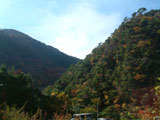

The mountain path passing next to the Arima Onsen Station of the Rokko-Arima Ropeway and continuing to the remains of Gokuraku-chaya resting house at Mt. Rokko is called "Momiji-dani Valley." As the name in Japanese implies, it is a place on the backside of Mt. Rokko with many deciduous trees that is famous for splendid autumn leaves. It is also well-known as a hiking course for enjoying each of the four seasons: cherry blossoms in spring, wild flowers in the summer, colorful leaves in autumn, and frozen waterfalls in the winter. The "48 Waterfalls of Arima" are found on this mountain path, and hikers relish the beautiful scenery year-round, including the winter when white ice crystals appear form in the surroundings of Mt. Rokko and the 48 Waterfalls of Arima freeze to form what is called "Ice Garden."
The distance from Tsuzumigataki Park to the top of Mt. Rokko is about 5km, and the area thickly covered with Japanese maple trees is splendid. The Sun and Greenery Road becomes a tunnel of colorful deciduous trees to fill you with the elegance of beautiful autumn.

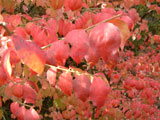
The Japanese inn "Goshobo" is located along the Takigawa River near the Hankyu Bus Arima Terminal. On the other side there is a stone guidepost (inscribed with "Pilgrim Path to Myoken Temple.") When you climb the stone path leading to temple for approximately 20 minutes, you'll arrive at the summit of Mt. Ochiba (533m elevation above sea level) overlooking the town of Arima Onsen from the west side. Legend has it that Mt. Ochiba Castle, or Arima Castle, existed here first during the Period of North and South Dynasties in the 14th century. The master of this mountain castle constantly changed, but in 1579 the castle was attacked by Oda Nobutada, the son of Oda Nobunaga, and fell. Currently, it is the location of the Myoken Temple.
Since few people enter the grounds, many rare types of broadleaf trees and flowering plants remain on Mt. Ochiba. In autumn, it is worth seeing the leaves of the numerous trees that turn colors, and it worth seeing the spectacular large ginkgo tree inside just below the main temple.













